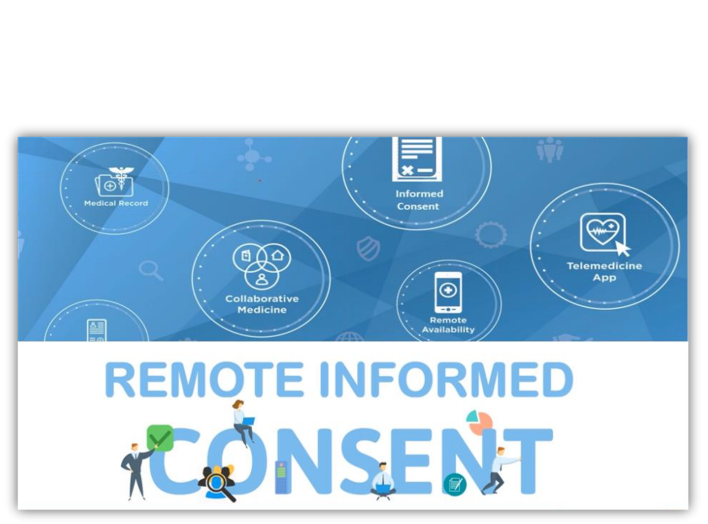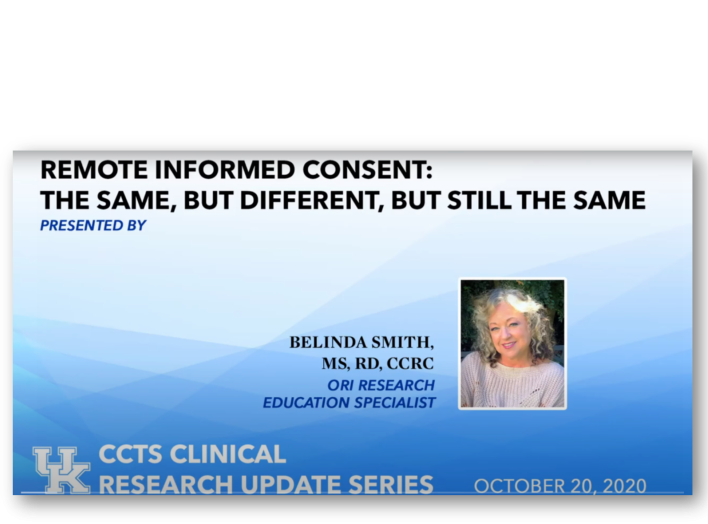No single set of recommendations fits all research needs. Options vary with the risk level and applicable regulations. Also, consider what would be feasible or preferable for your subject population. You may want to propose multiple or contingency plans to meet situational or individual participant needs.
Jump to: Process | Format | Videos
IRB Review
Your remote consent process must be prospectively reviewed and approved by the Institutional Review Board (IRB). Describe your plan(s) in the Research Description section (Informed Consent Process sub-section) of the E-IRB application.
Your consent plan should include:
- how the consent form is presented/reviewed,
- how signatures of the subject and/or LAR will be obtained,
- how the name of the study personnel obtaining informed consent will be documented,
- copies provided to subjects, and
- if applicable, screenshots showing the final formatting and features the subjects would see.
Include your consent document(s) as an attachment to your E-IRB application in the Informed Consent section.
Research Conducted with a Waiver of Signatures
A waiver of informed consent signatures is available for select studies, (i.e., telephone survey or mailed survey, internet research, or certain international research) if the research activities fit into one of three regulatory options:
- The only record linking the participant and the research would be the signed consent document, and the principal risk would be potential harm resulting from a breach of confidentiality (i.e., a study that involves participants who use illegal drugs).
- The research presents no more than minimal risk to the participant and involves no procedures for which written consent is normally required outside of the research context (i.e., a cover letter on a survey, or a phone script).
- The participant (or LAR) is a member of a distinct cultural group or community in which signing forms is not the norm and the research presents no more than minimal risk to the subject and there is an appropriate alternative mechanism for documenting that informed consent was obtained.
*Note: The IRB cannot waive the requirement for signatures or alter the consent form for research regulated by the Food and Drug Administration (FDA), unless it meets Option #2 – Minimal Risk Research.
For more information, see the Waiver of Signatures webpage [HTML]
Process
The aim is to replicate the capabilities of an in-person consent process. General requirements regardless of the format include:
- Provide the document to Participant/LAR in advance of the discussion
- Conduct a process to allow for an adequate exchange of information, answer questions and verify understanding
- Provide the subject with time to consider and verify that consent is voluntary
- Confirm that the signer of the consent form is the person who plans to enroll
- Retrieve the signed document
- Ensure the participant has a copy
- Ensure that the research staff receives the participant’s signed consent document before initiating study procedures
When live chat or video conferencing is used, investigators and study personnel should remind subjects to conduct the discussion in a private location to help ensure privacy and confidentiality. Document the conversation by noting:
- the date,
- names of individuals present,
- how the process was conducted,
- discussion points, and
- how the signed document is to be returned.
If added security is needed or if HIPAA applies to the research, employ cybersecurity precautions or secure/HIPAA videoconferencing as applicable.
- Standard UK Zoom [HTML] also offers security options and encryption.
- View Security under Settings for additional security steps such as setting passcodes or requiring participants to authenticate prior to joining.
- See Question 10 on the FAQs on Telehealth during COVID-19 [PDF] for other “non-public facing” platforms that allow only the intended parties to participate in the videoconferencing. (Please note: Unacceptable public-facing products are also listed.)
- UK Healthcare has a HIPAA compliant contract with Zoom for secure videoconferencing.
- Go to ukth.zoom.us to set up an account with your linkblue ID and password.
Subject in Medical Isolation
The FDA Covid-19 Guidance [HTML] provides the following process which may be used when Electronic Informed Consent is not available or feasible:
- A consent form, and HIPAA Authorization, if applicable, is provided to the patient (or, if applicable, the LAR) by a healthcare worker who can enter the room.
- If direct communication with the patient in isolation is not feasible or safe, the investigator obtains the patient’s phone number and arranges a three-way call or video conference with the patient, an impartial witness, and, if feasible, additional people as requested by the patient.
- If the signed and dated paper consent document can safely be collected, the person who conducted the consent conference prints his/her/their name and enters the current date on the form and provides the subject with a copy of the form(s) he/she/they signed.
- If the signed informed consent document cannot be safely collected from the patient’s location and included in the study records, the FDA considers the following two options acceptable for providing documentation that the patient signed the informed consent document:
- Method 1:
- A photograph of the signed and dated document is transmitted to the investigator or research staff.
- Place the photo of the signed consent in the subject’s study record along with an attestation that states how the photograph was obtained and that it is a photograph of the informed consent document signed by the patient.
-OR-
- Method 2:
- Three-way communication with a witness who is not otherwise connected with the research and, if desired and feasible, additional individuals requested by the patient.
- Alternatively, in lieu of using a witness, a recording of the conversation can be made and retained in the study record.
- After reviewing the consent and answering all questions, obtain verbal confirmation from the patient that they would like to participate, and they have signed and dated the consent document in their possession. Document the following in the study records:
- (1) a signed and dated attestation by the witness who participated in the call, that the patient confirmed their agreement to participate and signed and dated the informed consent document (or call recording); and
- (2) a signed and dated attestation by the investigator/designee stating why the informed consent document signed by the patient was not retained (e.g., contaminated).
- Method 1:
Format
The Office for Human Research Protections (OHRP) and Food and Drug Administration (FDA) permit the flexibility of using electronic and paper informed consent methods independently or in combination.
- Paper Informed Consent Documents - If a paper document is used, mail, fax, or email the consent form, and if applicable, the HIPAA Authorization, to the potential subject and/or LAR in advance of the remote process.
- Electronic Informed Consent – E-consent refers to the use of electronic systems and processes that may employ multiple electronic media, including text, graphics, audio, video, podcasts, passive and interactive websites, biological recognition devices, and card readers, to convey information related to the study and to obtain and document informed consent. For more information, see the E-consent webpage. [HTML]
Paper Informed Consent Documents
- Mail, fax, or email the consent form to the subject in advance.
- E-mail: Information Technology Services (ITS) and HealthCare IT have enabled Data Loss Prevention (DLP) in Microsoft Office 365, a feature that will auto-encrypt certain email messages based on the information contained within them.
- You can trigger the feature by using the keywords “#secure” or “#encrypt” in the subject line.
- The recipient then receives instructions on how to open the message.
- See more information at https://www.uky.edu/its/news/its-notificationdlp-email-encryption or contact ITS Customer Services at 859-218-HELP (4357) or 218help@uky.edu.
- E-mail: Information Technology Services (ITS) and HealthCare IT have enabled Data Loss Prevention (DLP) in Microsoft Office 365, a feature that will auto-encrypt certain email messages based on the information contained within them.
- Once the potential subject has the form and you have verified correct individuals are connected by phone or video, talk through the consent, answer questions, ensure the subject understands and consent is voluntary. You may document the conversation by noting:
- the date,
- names of individuals present,
- how the process was conducted,
- discussion points, and
- whether the person agreed to enroll.
- The subject may return the signed document electronically, via a prepaid envelope, or by scanning or photographing the signed and dated form and then sending the document to the investigator by email/fax/upload, etc.
- Document the study personnel who obtained consent by printing the name and date of consent obtained on the paper form.
- Ensure the subject is provided with a copy of the form(s) he/she/they signed.
Electronic Informed Consent (E-consent)
Electronic or E-consent refers to the use of electronic systems and processes that may employ multiple electronic media, including text, graphics, audio, video, podcasts, passive and interactive websites, biological recognition devices, and card readers, to convey information related to the study and to obtain and document informed consent. For more information, see the E-consent webpage. [HTML]



